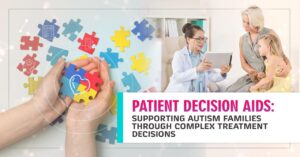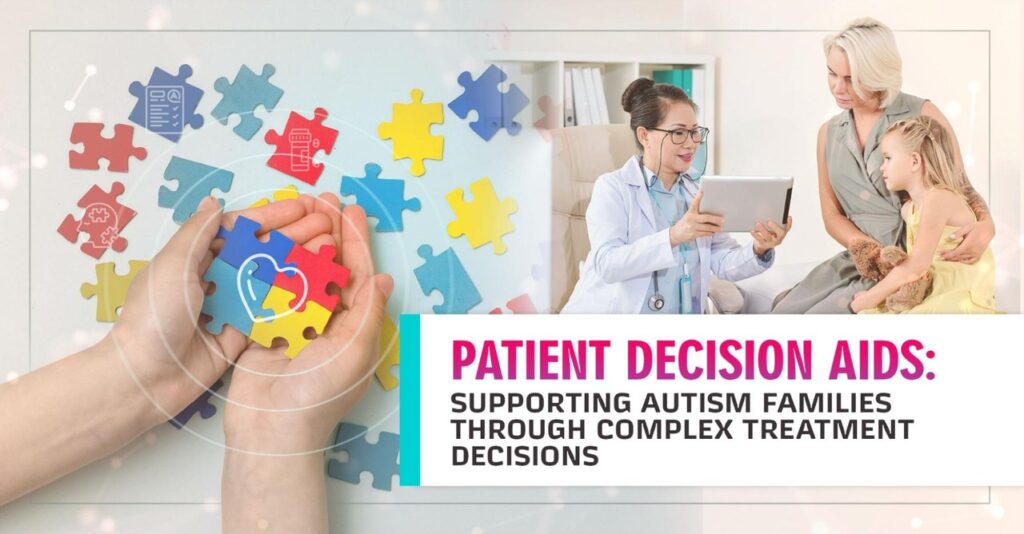
Supporting Autism Families Through Complex Treatment Decisions with Patient Decision Aids

Originally published on LinkedIn on July 9, 2025
When families receive an autism diagnosis, they’re often overwhelmed by conflicting treatment advice and endless intervention options. Last month, at the Society for Medical Decision Making Conference in Ann Arbor, powerful stories reminded us why supporting patients through difficult healthcare choices matters so much. Healthcare decision-making challenges exist across many conditions, but autism treatment decisions represent perhaps one of the most emotionally charged areas, where families face not only complex choices but also widespread misinformation.
Understanding Autism Spectrum Disorder
As defined by the Autism Society, Autism Spectrum Disorder (ASD), commonly referred to as autism, is “a complex, lifelong developmental condition that typically appears during early childhood and can impact a person’s social skills, communication, relationships, and self-regulation.” The Autism Society also notes that “the autism experience is different for everyone. It is defined by a certain set of behaviors and is often referred to as a ‘spectrum condition’ that affects people differently and to varying degrees.”
This spectrum nature of autism creates unique challenges for families of children on the autism spectrum seeking treatment guidance. What works for one autistic child may not work for another, making standardized treatment protocols difficult to establish and forcing families into a complex decision-making process often without adequate support.
The Information Flood After Diagnosis
Within hours of receiving the diagnosis, families find themselves flooded with treatment options, conflicting advice, and promises of “cures” from every direction. Behavioral therapies, speech therapy, occupational therapy, dietary interventions, medications—the list seems endless. Meanwhile, well-meaning relatives share articles about vaccine links, and online forums promote everything from specialized diets to dangerous “treatments” like bleach enemas.
As Dr. Alycia Halladay from the Autism Science Foundation recently stated on The New Yorker Radio Hour, “You will do anything to help your child, so if it means a bleach enema and you think that’s going to help them, you’ll do it. It’s not because these people don’t love their children. It’s because they’re desperate.”
This desperation, combined with contradictory information, creates the perfect storm for poor decision-making in autism care.
What Our Research Shows
Families in the autism community face an overwhelming array of choices with limited guidance on how to prioritize them. Unlike other medical conditions where treatment pathways are more standardized, autism interventions span multiple domains: behavioral, educational, medical, and complementary approaches.
Parents must navigate questions like: Should we start with Applied Behavior Analysis or try speech therapy first? Is this medication worth the potential side effects? How do we balance intensive interventions with family life?
Based on studies Bazis Americas has conducted, families struggle with several key challenges:
Treatment Selection Confusion: Parents report feeling overwhelmed by intervention options, from evidence-based therapies to unproven treatments marketed with compelling testimonials. As one parent in our ASD research shared: “Choosing the right medication for my child was very challenging. We had a lot of options, but understanding the differences between them was tough. It felt like we were constantly second-guessing our choices.”
Resource Allocation Stress: With limited time, energy, and financial resources, deciding which interventions to pursue becomes a source of constant anxiety and second-guessing. Many families report spending thousands of dollars on treatments without clear guidance on which approaches are most likely to benefit their specific child.
Conflicting Professional Opinions: Different specialists often recommend different approaches, leaving families to arbitrate between competing expert viewpoints without clear guidance. Another participant noted: “Our psychiatrist was incredible… he laid out the different side effects and he explained thoroughly why he prescribed one thing instead of another. But I heard so many horror stories. I had never heard of other people having such a smooth experience.”
Misinformation Vulnerability: In their desperation to help their children, families can fall prey to false claims and dangerous treatments that exploit their hope and determination.
Long-term Planning Challenges: Unlike acute medical conditions, autism requires long-term treatment planning that must evolve as children diagnosed with ASD grow and develop. Families struggle with decisions about educational placements, transition planning for adulthood, and preparing for lifelong support needs for individuals with autism.
How Decision Aids Could Help
This is precisely where autism-specific decision aids could change family experiences. Rather than leaving parents to navigate these complex decisions alone, structured tools could help families identify what matters most to them and align treatment choices with their values and circumstances.
An effective autism decision aid might help families prioritize goals based on their child’s specific needs, understand the evidence base for different interventions, explore trade-offs between intensive therapies and family quality of life, and identify red flags for unproven treatments.
Using validated research methodologies like conjoint analysis — techniques Bazis Americas has successfully applied in other healthcare decision aids — families could work through structured scenarios that help clarify their priorities and preferences. For example, parents might weigh factors such as communication skill development, behavioral intervention approaches, sensory support needs, and educational placement options.
The decision aid could also provide personalized risk assessments, helping families understand which interventions are most likely to benefit their specific child based on age, severity of symptoms, and co-occurring conditions.
At Bazis Americas, we’ve seen how decision aids create more confident, informed patients across various conditions. In autism care, these tools could provide families with the evidence-based framework they desperately need while respecting their unique circumstances and values.
Such tools would need to address both immediate treatment decisions and long-term planning considerations. They should help families understand realistic expectations for different interventions, plan for transitions between developmental stages, and prepare for adult independence or supported living arrangements.
The decision aid could also facilitate better communication between families and healthcare providers by helping parents articulate their priorities and concerns more clearly.
Thus, the development of autism-specific decision aids represents an opportunity to improve how families navigate the complex landscape of autism treatment options, moving from confusion and desperation toward informed, values-based decision-making.



